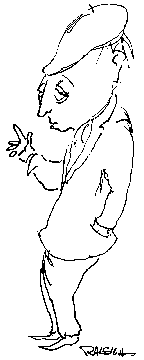 |
Film Writing Styles
By Henry P.
Raleigh
ART
TIMES May
2006
EVER IN PURSUIT of self-improvement, to say nothing
of greater excellence, I have been considering several styles of film
writing to find one or two, perhaps a synthesis of both, that would be
most appropriate to my critical sensibilities. I think of this because
it occurs to me that I might have been overly casual, even folksy, at
times — though, heaven knows, acute enough in my observations.
Let’s take what I call the French Approach. Intellectually
deep, it is heavily freighted with dazzling theory and searches out sub-texts
and symbolic meaning like there’s no tomorrow (there, I slipped into my
down-home style for a moment). Well, at any rate, this sort of literary
style exhaustively strives to separate (ala Andre Bazin — a Frenchman
and pretty smart, too) the ‘filmic’ from the ‘cinematic’. I confess I’m
not at all that clear yet on the difference except to call a film a ‘Cinematic
Experience’ is a lot better than to toss it off as just another film.
For some reason, I guess, French film critics do not have ‘Filmic Experiences’
or if they do it makes them nauseous. Mind-boggling terms are de rigueur
(notice how neatly I slipped that in — it’s French, you know)
especially if French in origin like montage, mise-en-scene and fricassee
(?). While we know that the film analysis known as ‘De Construction’ was
invented by the French who later abandoned it in a pique as ‘chapeau vieux’,
everyone still does it (avoir la passion de sexe, as we like to say but
I may have this wrong).
Let’s try the French Approach on the film “House of
Wax” — a film that has been largely ignored for petty reasons mostly
because it stars Paris Hilton but is chock full (plein) of “Cinematic
Experiences’ — mostly Paris Hilton. To start with, we’ll place it
within a ‘genre’ (this gives it an immediate cachet — and another
French word) along with “The Texas Chainsaw Massacre” to which it bears
a close apparence (appearance) and is, success formidable (wow), a subtle
commentaire on the entire genre and probably a number of other things,
too. Ms Hilton’s acting performance is studiously eponvantable (terrible)
thus referencing the Freudian principle that a total lack of talent doesn’t
prevent you from being rich and somptueux (a hotty) even when skewered
through the head. That the town Ms Hilton and her gang stumble upon and
its inhabitants are entirely made of wax is certainment (you can figure
that one out) a sub-texted criticism of our industrial/capitalistic/fast
food (I’m sure that’s in there someplace) complex and probably a number
of other things, too. I have an idea that avoir la passion de sexe may
fit better here. It fits Ms Hilton, all right, n’est-ce pas?
The second style of film writing I have in mind goes
only by the adjectives ‘Cool’ or ‘Hip’ or ‘Hip-Hop’ or an adverb ‘With
It”, sometimes followed by ‘Man’ or ‘Dude’ and the reader is required
to be ‘Down’ in order to ‘Dig It’. It might be that some of these terms
are dated (not Cool). I’m not sure about ‘Dig’ or even ‘Cool’, for that
matter, but see that’s the thing about this writing style — it has
to be right up to the minute with all the in-terms, making them up as
needed to show just how ‘Cool’ and ‘In’ you are. This style of film writing
tells the world you are so deep in the film loop that you write in a language
that only other ‘In’ people can make heads or tails of. Metaphors, similes,
and hyperbole are prominent in this style, if not all of it. Entire paragraphs
can be assembled by simply stringing these together, avoiding verbs and
taking care to never complete a sentence — or thought. Here’s an
example:
“Fun with
Dick and Jane hits with a soft brick like cream cheese and bagels while
eye-balling Tea Leoni ditto Oscar time and Carreu Tarries or would we
say Sooper-Dooper Slim Jim drops it like an NFL wide-receiver. Is that
a can or sushi, or what?”
See what I mean — catchy. In similar manner “House
of Wax” turns out as:
“A round-trip
to Paris, cheapo too, so darlin’ no First Class but who needs the waxey
dudes when Slinky Hilton (anyone for decapitation and a gigandus SUV?)
rocks your yachts like a Nor’Easter through the Hamptons, say Shazam a
gas, righty-o.”
The advantage of this Cool style is that it’s short
and to the point. Or some point if one has been actually made somewhere
in the midst of the cool. Having a critical point to make isn’t really
of much concern. It’s just great fun to read and wonder what was said,
n’est-ce pas?
I’m going to ask my wife which style suits me.
